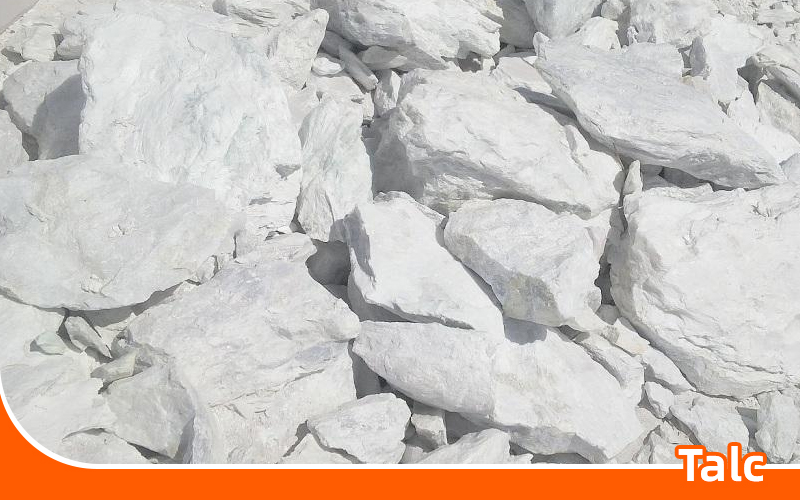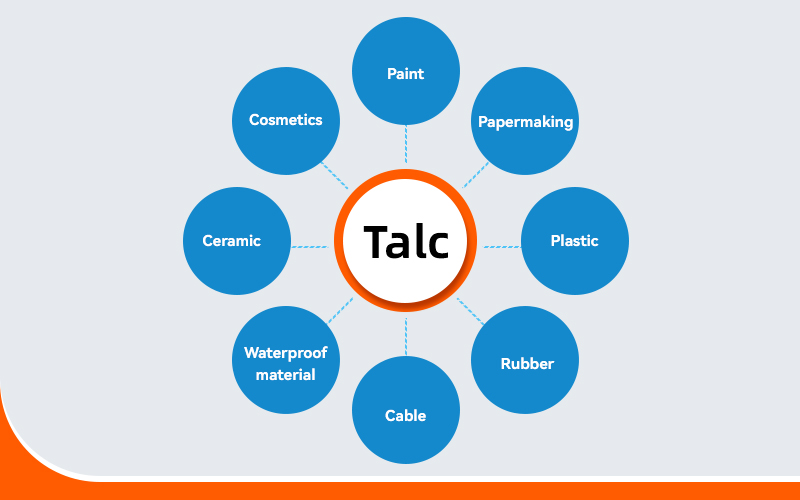Recently, Johnson & Johnson faced significant legal liabilities due to potential cancer risks associated with its
talc powder, reigniting concerns about its safety. This concern stems from the possible presence of asbestos, a known carcinogen, in some talc ore deposits.
Is talc safe to use? In its pure form, talc mineral is considered safe and non-carcinogenic. Industrial
talc mining and processing typically do not involve asbestos contamination, ensuring the safety of talc
products for consumers.
This blog focuses on enhancing the whiteness and fineness of talc powder to meet diverse market specifications in industries such as ceramics, cosmetics, paper, rubber, and paint.
Talc Market Specifications
Due to the different impurities and minerals it contains, the color of talc minerals may appear white, gray, green, pink, etc. The talc powder used in industry is usually refined to ensure its color is relatively pure white to meet the requirements for color purity in industrial production.

Each field has specific requirements for talc's purity, fineness, whiteness, and flake structure.
High-purity talc powder is particularly suited for industries with stringent mineral standards, such as cosmetics and pharmaceuticals. While the whiteness of talc powder does not directly impact talc's physical properties, it is crucial for maintaining color purity in light-colored products.
Talc powder's flake structure affects its strength and reinforcing capabilities, with purer talc exhibiting superior flake structures. Additionally, talc powder's fineness influences its reinforcing effects, with miniaturization being a key development trend in talc products.

Below are the detailed industry requirements for talc powder.
| Industry | Whiteness | Fineness(mesh) | Purity | Moisture |
| Cosmetics | ≥80% | 200–500 | SiO2≥57%, MgO≥28%, Fe2O3≤1.3% | ≤1% |
| Paint | ≥70% | 400–1250 | SiO2≥30%, MgO≥22%, Fe2O3≤0.4% | ≤0.2% |
| Papermaking | ≥90% | 400–2000 | SiO2≥45%, MgO≥25%, Fe2O3≤0.3% | ≤0.2% |
| Plastic | ≥70% | 400–2000 | SiO2≥45%, MgO≥25%, Fe2O3≤0.3% | ≤1% |
| Rubber | / | 400–2000 | SiO2≥45%, MgO≥25%, Fe2O3≤0.3% | ≤1% |
| Cable | / | 400–2000 | SiO2≥45%, MgO≥25%, Fe2O3≤0.3% | ≤1% |
| Ceramic | ≥75% | 325–1250 | SiO2≥45%, MgO≥25%, Fe2O3≤1% | / |
| Waterproof material | ≥60% | 400–1250 | SiO2+MgO≥77%, Fe2O3≤0.4% | ≤1% |
Ultra-white Fine Talc Production Process
Talc beneficiation differs from other mineral processing methods, as its primary goal is to enhance whiteness.
Whiteness is a key criterion for evaluating talc product quality across various industries.
Moreover, by removing impurities, the process also boosts purity and raises the concentration of valuable minerals in
talc.
This article outlines six steps, including grinding, magnetic separation, flotation separation, bleaching,
calcination, and re-magnetic separation, to help you produce high-white superfine talc powder.
Step I Grinding
Given that talc will be turned into a slurry later on, wet grinding is preferable for the grinding
process. This method reduces the risk of dust issues and ensures a more uniform particle size.
It is recommended to use wet grinding for talc, where the talc is first crushed and then processed in a ball mill to achieve a particle
size of 0.074 mm for slurry production.
Step II Magnetic separation
The associated minerals of talc may contain magnetic minerals such as hematite and iron sand, which affect
the
fineness and whiteness of talc. To reduce the iron content, the slurry needs to pass through a wet magnetic separator to
remove iron, reducing the iron content of talc to less than 1%.
Step III Flotation separation
After magnetic separation, the slurry concentration is adjusted to 25% for fluoride-free flotation, which removes
harmful trace elements such as potassium, sodium, and aluminum.
Talc's natural hydrophobicity allows bubbles to easily adsorb to its surface in the flotation tank, facilitating talc flotation without the need for a collector. Only MIBC frother and CMC inhibitor are required. Following flotation, the slurry concentration is raised to 50%, and chemicals are added to further remove impurities.
The pharmaceutical ratio is raw ore: water: pharmaceutical = 100:50:30, with oxalic acid and hydrochloric acid forming
the pharmaceutical at a ratio of oxalic acid: hydrochloric acid = 20:10. Stirring at room temperature for 0.5–3 hours
promotes impurity removal through a chemical reaction.
Step Ⅳ Bleach
The commercial value of talc is closely related to its whiteness. To improve the whiteness, it is recommended to
carry out bleaching treatment after flotation.
In the slurry after impurity removal, add 0.5–3 kg of reducing powder for bleaching, and then wash it with clean water
2–3 times. The PH value of the bleached slurry reaches 6.8–7.5.
Step Ⅴ Calcination
After bleaching, the talc enters the rotary kiln for calcination. The calcination temperature is 800–1300°C and the calcination time
is 3–4 hours.
It is recommended to add 4–8 kg of sodium chloride whitening agent per ton during the calcination process. During the calcination process, sodium chloride gradually removes part of the crystal water and organic matter by destroying the crystal structure lattice, thereby whitening and removing impurities.
Step Ⅵ Magnetic separation
The calcined and cooled talc enters the magnetic separator again to remove iron. Choosing a dry magnetic separator can also help break
up the agglomerated powder.
Finally, a high-quality talc powder with a whiteness of 95%–99%, a
fineness of 800 mesh, and a Mg content of more than 33% is obtained.

